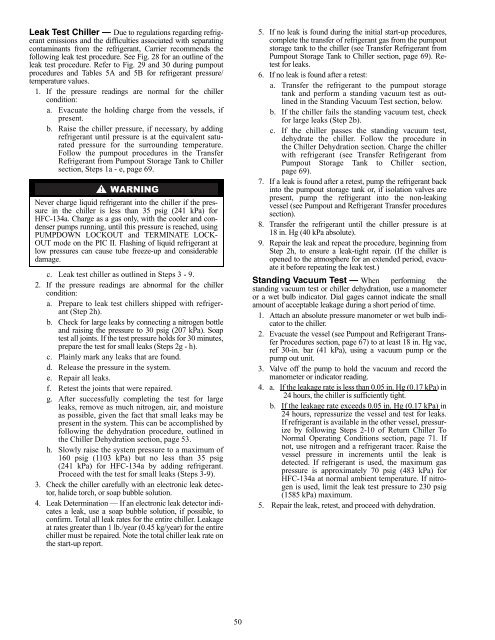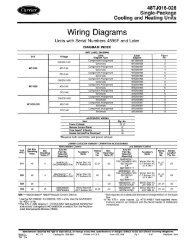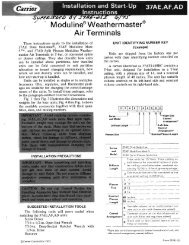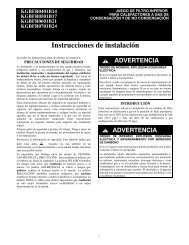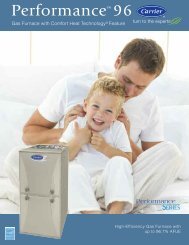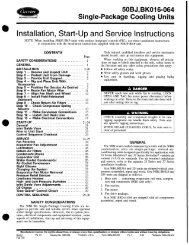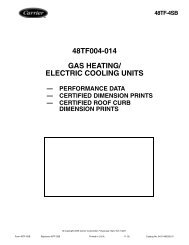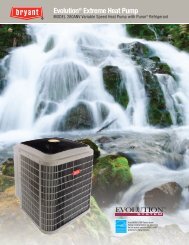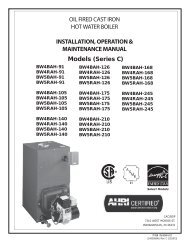Start-Up, Operation, and Maintenance Instructions
Start-Up, Operation, and Maintenance Instructions
Start-Up, Operation, and Maintenance Instructions
You also want an ePaper? Increase the reach of your titles
YUMPU automatically turns print PDFs into web optimized ePapers that Google loves.
Leak Test Chiller — Due to regulations regarding refrigerant<br />
emissions <strong>and</strong> the difficulties associated with separating<br />
contaminants from the refrigerant, Carrier recommends the<br />
following leak test procedure. See Fig. 28 for an outline of the<br />
leak test procedure. Refer to Fig. 29 <strong>and</strong> 30 during pumpout<br />
procedures <strong>and</strong> Tables 5A <strong>and</strong> 5B for refrigerant pressure/<br />
temperature values.<br />
1. If the pressure readings are normal for the chiller<br />
condition:<br />
a. Evacuate the holding charge from the vessels, if<br />
present.<br />
b. Raise the chiller pressure, if necessary, by adding<br />
refrigerant until pressure is at the equivalent saturated<br />
pressure for the surrounding temperature.<br />
Follow the pumpout procedures in the Transfer<br />
Refrigerant from Pumpout Storage Tank to Chiller<br />
section, Steps 1a - e, page 69.<br />
Never charge liquid refrigerant into the chiller if the pressure<br />
in the chiller is less than 35 psig (241 kPa) for<br />
HFC-134a. Charge as a gas only, with the cooler <strong>and</strong> condenser<br />
pumps running, until this pressure is reached, using<br />
PUMPDOWN LOCKOUT <strong>and</strong> TERMINATE LOCK-<br />
OUT mode on the PIC II. Flashing of liquid refrigerant at<br />
low pressures can cause tube freeze-up <strong>and</strong> considerable<br />
damage.<br />
c. Leak test chiller as outlined in Steps 3 - 9.<br />
2. If the pressure readings are abnormal for the chiller<br />
condition:<br />
a. Prepare to leak test chillers shipped with refrigerant<br />
(Step 2h).<br />
b. Check for large leaks by connecting a nitrogen bottle<br />
<strong>and</strong> raising the pressure to 30 psig (207 kPa). Soap<br />
test all joints. If the test pressure holds for 30 minutes,<br />
prepare the test for small leaks (Steps 2g - h).<br />
c. Plainly mark any leaks that are found.<br />
d. Release the pressure in the system.<br />
e. Repair all leaks.<br />
f. Retest the joints that were repaired.<br />
g. After successfully completing the test for large<br />
leaks, remove as much nitrogen, air, <strong>and</strong> moisture<br />
as possible, given the fact that small leaks may be<br />
present in the system. This can be accomplished by<br />
following the dehydration procedure, outlined in<br />
the Chiller Dehydration section, page 53.<br />
h. Slowly raise the system pressure to a maximum of<br />
160 psig (1103 kPa) but no less than 35 psig<br />
(241 kPa) for HFC-134a by adding refrigerant.<br />
Proceed with the test for small leaks (Steps 3-9).<br />
3. Check the chiller carefully with an electronic leak detector,<br />
halide torch, or soap bubble solution.<br />
4. Leak Determination — If an electronic leak detector indicates<br />
a leak, use a soap bubble solution, if possible, to<br />
confirm. Total all leak rates for the entire chiller. Leakage<br />
at rates greater than 1 lb./year (0.45 kg/year) for the entire<br />
chiller must be repaired. Note the total chiller leak rate on<br />
the start-up report.<br />
50<br />
5. If no leak is found during the initial start-up procedures,<br />
complete the transfer of refrigerant gas from the pumpout<br />
storage tank to the chiller (see Transfer Refrigerant from<br />
Pumpout Storage Tank to Chiller section, page 69). Retest<br />
for leaks.<br />
6. If no leak is found after a retest:<br />
a. Transfer the refrigerant to the pumpout storage<br />
tank <strong>and</strong> perform a st<strong>and</strong>ing vacuum test as outlined<br />
in the St<strong>and</strong>ing Vacuum Test section, below.<br />
b. If the chiller fails the st<strong>and</strong>ing vacuum test, check<br />
for large leaks (Step 2b).<br />
c. If the chiller passes the st<strong>and</strong>ing vacuum test,<br />
dehydrate the chiller. Follow the procedure in<br />
the Chiller Dehydration section. Charge the chiller<br />
with refrigerant (see Transfer Refrigerant from<br />
Pumpout Storage Tank to Chiller section,<br />
page 69).<br />
7. If a leak is found after a retest, pump the refrigerant back<br />
into the pumpout storage tank or, if isolation valves are<br />
present, pump the refrigerant into the non-leaking<br />
vessel (see Pumpout <strong>and</strong> Refrigerant Transfer procedures<br />
section).<br />
8. Transfer the refrigerant until the chiller pressure is at<br />
18 in. Hg (40 kPa absolute).<br />
9. Repair the leak <strong>and</strong> repeat the procedure, beginning from<br />
Step 2h, to ensure a leak-tight repair. (If the chiller is<br />
opened to the atmosphere for an extended period, evacuate<br />
it before repeating the leak test.)<br />
St<strong>and</strong>ing Vacuum Test — When performing the<br />
st<strong>and</strong>ing vacuum test or chiller dehydration, use a manometer<br />
or a wet bulb indicator. Dial gages cannot indicate the small<br />
amount of acceptable leakage during a short period of time.<br />
1. Attach an absolute pressure manometer or wet bulb indicator<br />
to the chiller.<br />
2. Evacuate the vessel (see Pumpout <strong>and</strong> Refrigerant Transfer<br />
Procedures section, page 67) to at least 18 in. Hg vac,<br />
ref 30-in. bar (41 kPa), using a vacuum pump or the<br />
pump out unit.<br />
3. Valve off the pump to hold the vacuum <strong>and</strong> record the<br />
manometer or indicator reading.<br />
4. a. If the leakage rate is less than 0.05 in. Hg (0.17 kPa) in<br />
24 hours, the chiller is sufficiently tight.<br />
b. If the leakage rate exceeds 0.05 in. Hg (0.17 kPa) in<br />
24 hours, repressurize the vessel <strong>and</strong> test for leaks.<br />
If refrigerant is available in the other vessel, pressurize<br />
by following Steps 2-10 of Return Chiller To<br />
Normal Operating Conditions section, page 71. If<br />
not, use nitrogen <strong>and</strong> a refrigerant tracer. Raise the<br />
vessel pressure in increments until the leak is<br />
detected. If refrigerant is used, the maximum gas<br />
pressure is approximately 70 psig (483 kPa) for<br />
HFC-134a at normal ambient temperature. If nitrogen<br />
is used, limit the leak test pressure to 230 psig<br />
(1585 kPa) maximum.<br />
5. Repair the leak, retest, <strong>and</strong> proceed with dehydration.


